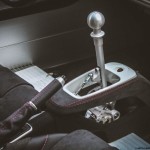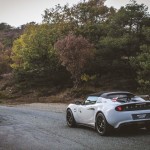
Lotus Elise Cup 250: Night Stalker – Performance Tour
LOTUS ELISE CUP 250
PERFORMANCE TOUR – EPISODE V
NIGHT STALKER
Words: Alessandro Marrone
Photography: Richard Montagner
Darkness hides so many things. It’s almost like, in the shadows, we can do something that would be unprofessional during the day, washing our conscience before the sun comes back to wake the city and put us in the spotlight, among the people who frantically hurry to get back to work. The small Elise Cup 250 breaks the rules of understatement from the moment you enter the key and press the Start button, until – after the usual inhuman efforts – you pull yourself out of the passenger compartment. The winding road that goes down to Monaco and the motorway cruise have been a taste of its potential, because you know very well that for getting closer to the car’s mechanical limit you’d need a lot of hair on the stomach and much more intimacy with Hethel’s lightweight creature par excellence. Built around the driver, you wear it like a tight dress and after a couple of hours, you start to build a muscular relationship with it – the more classic movements like changing a gear, pressing the clutch and pointing the apex of a corner become something impressive for the crazy amount of inputs you get and having semi-slick tires with forged rims of smaller size than usual (16 inches at front and 17 at the back), transmits a directionality that you will not find on any other sports car, regardless of price and brand.
I find myself driving in the night, with the windows down to give voice to the supercharged four-cylinder mounted behind my shoulders. The 1.8, which delivers 246 horses on the Cup 250, is generous and is always ready to support me, showing an elastic nature, even when I decide not to call into question a lower gear and so it reaches the torque curve with more calm than usual. The silence of a deserted road that has cars parked on the sides and a black sky that seems wanting to swallow the world below itself as only spectators is pretty unnatural. There is no better way to hear those thousand mechanical sounds, exposed to the mercy of an insatiable listener, observing the open-gate gearshift lever and the big rear spoiler that proudly shows the Union Jack on its side – look at it for a few seconds and you’ll start seeing it trembling nervously due to the imperfection of the road surface. The optional carbon fiber kit is fitted on the specimen given to me by Gino Luxury & Performance, star of the fifth episode of our Performance Tour, everything adds drama to the Elise’s look that turns into a rebellious punk ready to go brawling with the world. At the same time, you save extra weight by lowering the scale of 10kg and producing 155kg of downforce (once the maximum speed is reached). The kit is composed of, among other things, front spoiler, side skirts and a huge rear diffuser that gives space to the single tailpipe, right in the middle of it. There is so much carbon fiber, but my eyes are still fascinated by that nudity that can make you feel comfortable after having done the right thing. The gearshift lever is very close, the bucket seats (always in carbon fiber) are quite comfortably and offer the option of mounting four-points harnesses, while the rest of the passenger compartment still leaves place to the steering wheel, pedals and the climate controls (optional) and stereo (which I do not think it would be used). You’re in close contact with the passenger, but over 120 kph it will be difficult to hear him saying to slow down, whether it is about the noise coming from the outside, or for the fact that maybe he’s having a hell of a ride.
At 130 kph, you feel sticky on the ground and keep your hands firm on the steering. At 160 you get some air from the removable roof, at 200 you do not have time to think or look other than the road, calculating every little movement of a small missile fired towards automotive glory. But a Lotus called Cup does not intend to point at pure speed, as much as to the exaltation of the man-machine relationship, through a rain of sensory inputs that rise up to the chassis and are transmitted to our spine and then to our brain. You think of dealing with a corner in a precise way and you can execute that with the utmost precision you had figured in your head, with a surgery-like steering, and with a reduced run gearbox, but with the right ratios, allowing you to pull the first gear as a scumbag, going to speeds where aerodynamics begins to come into play. Placed as a fierce predator, the Elise Cup 250 slams into the curves and smashes them with greed, demanding to be pushed more at every following attempt. Without even realizing it, the Tenda pass and some appropriate deviations lead me to the Col de Castillon, a road I know pretty well. No other moment was more pleasing to declare my promise to the most extravagant Elise ever produced for road use.
The 931kg of weight seem to accuse my lunch stop, but the supercharger helps to wipe away every bit of embarrassment, bringing the unmistakable hiss into the passenger cabin, which from 3500 to 5000 revs comes with the 250Nm of maximum torque. And then we have to keep it down, keep everything down as if we despised life or as if it itself had as its sole goal the search and the overcoming of our personal self-preservation barrier. It’s not easy to reach, but the concreteness with which the Cup 250 transmits the right information makes us realize that we are finally learning to drive and that before it has always been a fun wait. Semi-slick tires must reach the right temperature and do not like the wet roads or even light gravel on the edges, but once they are hot and ready, they are responsible for shrinking your guts irreversibly. The smiling face at the front betrays, because even though it does not intend to kill you as a Corvette would, the Cup 250 would be bothered and jump all the preliminaries without problems, if only we could do the same. That’s why a mountain road and a race track are the ideal (albeit diametrically opposed) places where the ultimate chassis can meet its purpose, demonstrating that for experiencing strong emotions it’s not necessary to fit a jet engine into a ground hugging super expensive hypercar. It’s about driving, driving for hours, for whole days, aware that if I started to have a back pain, I would end up with a series of sessions to the osteopath – it would be worth it, and indeed it just did. But it’s not over because, apart from the 4.3 seconds needed to reach the 100-hour from standing still and a top speed of 248 kph, the Cup 250 shared with me even more reflexive moments. In the solitude of the night, away from all the chaos of the day, I traveled those roads from which common sense would keep you away, once at the wheel of a super-light sports car designed for the curbs. Widespread intersections, empty streets, with shop windows to reflect the extreme and nonconforming image of the small Lotus. No acceleration out of the ordinary, no intention to call into question the true nature of our warrior, only the 1.8 that breathes at 1500/2000 rpm and the “clank” metal sound of the g’box lever playing with the clutch pedal. A hallucinatory joy that in the frenzy of the day, spent largely through fire and flames on roads that seem to be designed to violate our driving innocence, gives me a sense of peace and invites me to continue to drive until sunrise , which as an alarm urges me to move away from the city center, to hide back in the mountains, as an outlaw in the most typical western scenery would do. A last turn of the city still overwhelmed, a last deserted street that is being harassed by the smallest and most terrible stalker that has ever crossed the night.
LOTUS ELISE CUP 250 (2017-)
Layout – mid-rear engined, rear wheel drive
Engine – 4 cylinder 1.8cc – supercharged
Transmission – 6-speed manual gearbox
Power – 246 hp @ 7.200 rpm
250 Nm @ 3.500-5.000 rpm
Weight – 931 kg
Acceleration – 4,3 sec.
Top Speed – 248 kph
Price brand new – da 65.010 €
Gino Luxury & Motorsport Price – € 68.900*
*(as tested)






















